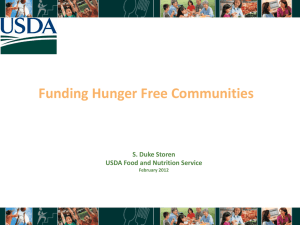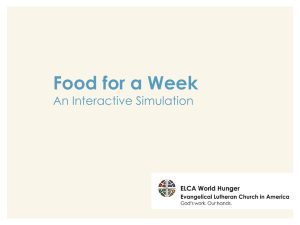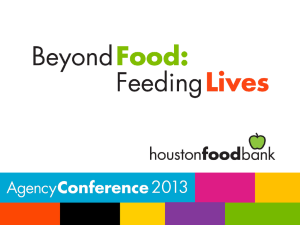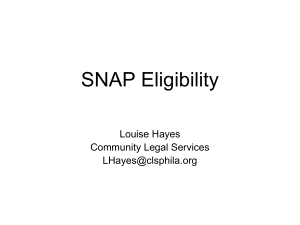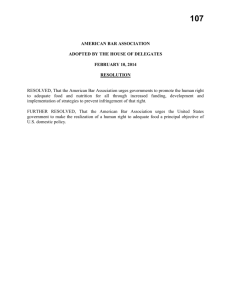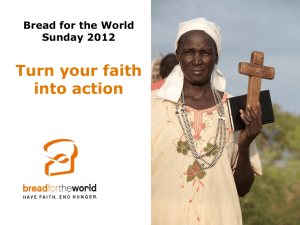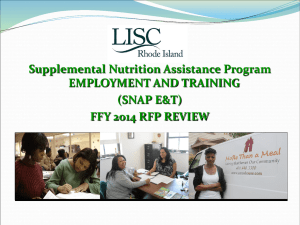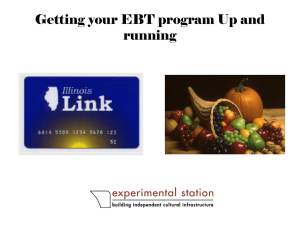Link to Hunger in NM Panel Handout1
advertisement
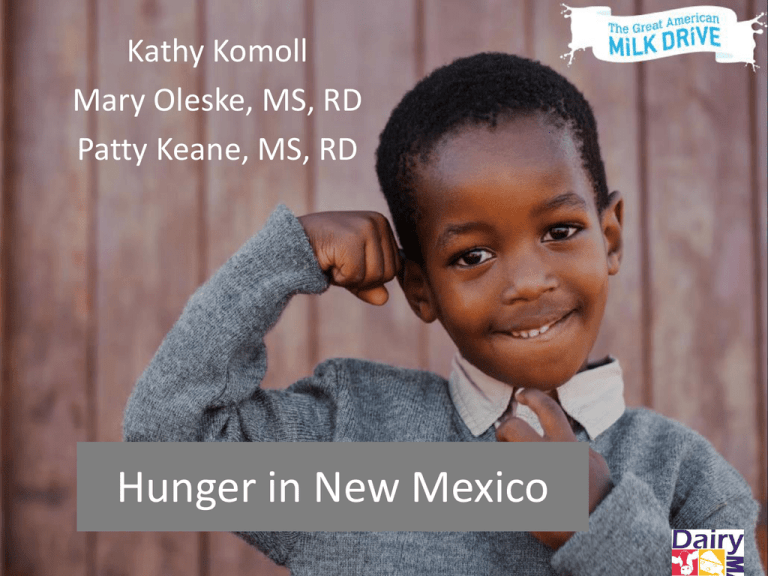
Kathy Komoll Mary Oleske, MS, RD Patty Keane, MS, RD Hunger NewMexico Mexico Hunger in New http://healthyfoodbankhub.feedingamerica.org Online Giving www.milklife.com/give Text to Donate $5 Text Milk to 27722, enter zip code Retailer Events: Albertson’s $1, $3, $5 donations at checkout Kathy Komoll Director, New Mexico Association of Food Banks 5 In 2006, the descriptions of categories were revised to better describe food insecurity. Together, these 2 categories measure food insecurity— Low Food Security: People who have had to make changes in the quality or quantity of their food in order to deal with a limited budget Very Low Food Security: People who have struggled with not having enough food for the household, including cutting back or skipping meals on a frequent basis for both adults and children. Note * While the word hunger has been removed from the descriptions used in these surveys, it should not be interpreted to mean that there has been a major shift in the incidence of hunger. 6 Chronic illness, disability, low fixed income High costs of living Rural lack of access to jobs and services Unemployment, underemployment, lack of education Unexpected crises (medical, financial, etc.) 7 Total NM 21.5% Total US 15.0% NM Children 30.7% US Children 21.9% NM Seniors 15.0% US Seniors 8.7% Note *Poverty levels for a family of 3: $19,090 (100%)-$24,817 (130%)$35,317 (185%) 8 Total NM 20.1% NM Children 30.6% NM Seniors 21.0% Total US 16.4% US Children 22.4% US Seniors 8.4% 9 Every week, nearly 40,000 New Mexicans seek food assistance. That’s the equivalent of a city the size of Farmington needing emergency assistance four times every month. 40% of the members of households seeking food assistance are children under the age of 18. 7% of those children are under the age of 5. 13% of the people seeking food assistance in New Mexico are senior citizens. 41% of households needing food assistance report having at least one member in poor health. 70% of food pantry programs in New Mexico rely entirely on volunteers. The average monthly income for a household seeking food assistance is $900/month. 10 11 For additional information, including Map the Meal data by congressional district or county, please contact Kathy Komoll, New Mexico Association of Food Banks. 505-217-1066 nmafb@aol.com 12 Accessibility to sources of healthy food, as measured by distance to a store or by the number of stores in an area. Individual-level resources that may affect accessibility, such as family income or vehicle availability. Neighborhood-level indicators of resources, such as the average income of the neighborhood and the availability of public transportation. Many areas of New Mexico are food deserts: Economic Research Service (ERS), U.S. Department of Agriculture (USDA). Food Access Research Atlas, http://www.ers.usda.gov/data-products/food-access-researchatlas.aspx. 13 14 SNAP – Supplemental Nutrition Assistance Program TEFAP – The Emergency Food Assistance Program Federal/state school breakfast/lunch programs WIC – food assistance for mothers with children Child and Adult Care Food Program Commodity Supplemental Food Program FDPIR –Food Distribution Program on Indian Reservations Summer meal programs (private sector, CYFD/PED) Senior programs – state SNAP supplement, congregate meals, home delivered meals Homeless shelters Food Banks – statewide network of more than 400 agencies 15 Program Administering Agency/Funding Source Eligibility Current Served SNAP HSD/USDA 165% of poverty to apply;100% poverty or below to receive benefits TEFAP HSD/USDA 185% of poverty 43,643 per month January 2012-December 2012 CSFP 100% Federal Funds 185% of poverty (WIC); 130% of poverty (Seniors 16,428 seniors (60+) and women and children (up to age 6) School Breakfast USDA/PED 443,784 individuals in June 2013 (197,621 were children) Free (130% of poverty); Reduced (185% of poverty) 888 schools 16 with all these private and public programs, New Mexico still has one of the highest rates of hunger in the country….. 17 Increase state SNAP supplement so the elderly and people with disabilities receive additional monthly SNAP benefits Advocate to protect SNAP from cuts Increase state funding for the Fresh Produce Initiative Increase the minimum wage Encourage economic development that provides well paying jobs 18 Enact stronger enforcement of the wage theft law Fund the Individual Development Account program to help low-income families build their financial assets Improve public transportation Implement effective early childhood education Increase Medicaid outreach and facilitate enrollment Increase access to Adult Basic Education, job training and ESL classes 19 Increase availability of affordable housing by funding the State Housing Trust Fund and permanent supportive housing services Fund state child care assistance at 200% of the poverty line Increase Working Families Tax Credit (at least 5%) Increase the Low Income Comprehensive Tax Rebate Visit a mobile or other food pantry in your district 20 Every week, 40,000 New Mexicans are faced with the uncertainty of not knowing where their next meal is coming from. The challenge of meeting that need is more than the private sector can handle. The public and private sector must continue to work together to create solutions and build systems that put food on every table. 21 22 23 33% of SNAP participants are children, elderly or disabled, people one would not expect to work. The majority of ablebodied adult SNAP participants are working or trying to work. SNAP program structure provides a strong incentive to work. SNAP program rules place strict time limits on those who are not working. The House nutrition-only farm bill would eliminate waivers that allow states to provide food assistance when jobs are scarce, shifting burden to charities and state and local governments at a time of high unemployment and historic need. 24 While we can all agree that jobs are the best solution to hunger and poverty, jobs remain elusive for many low income families. The SNAP cuts proposed in the House farm bill would lead to 15 billion lost meals for low-income families. Congress should reject cuts to SNAP. SNAP participation and spending will go down as the economy recovers, without the need to cut food assistance for low-income people. (For additional information on these points, please refer to SNAP Program Overview, SNAP Facts Myths and Realities, and SNAP and Work Talking Points in your resource guide.) 25 Map the Meal Gap: Uses Census data from the Current Population Survey (CPS) in which people are actually surveyed about whether they ran out of food and how much more money they needed to meet their household food needs CPS Data used to arrive at weekly budget shortfalls Localized (county level) average meal costs calculated from data provided by Nielsen which collects data about all food items scanned in the country in 26 different food categories by age and gender of purchaser Food Insecurity determined by complex formula which takes into account poverty, unemployment, median income, home ownership, ethnicity and affirmative answers to certain questions on the CPS All Feeding America research accompanied by technical briefs that explain methodology and sources of data (see sample attached) 26 Hunger Study: Conducted nationwide every four years by virtually all Feeding America food banks in the United States Food banks collect data according to a strict data collection protocol dictated by the national research firm contracted by Feeding America for the purpose Research firm for data we use now was Mathematica Policy Research One part of the study involved collection detailed surveys from virtually every emergency food provider (food pantries, shelters and soup kitchens) in the United States; 37,000 surveys were collected in 2009 The second part of the study is random interviews of clients at randomly selected emergency food sites; in 2009 62,000 random, anonymous client interviews were obtained in the U.S. Data collection for 2013 has been completed working with research firm Westat; results will be released in the spring of 2014 (looks like it will be May) 27 28 Hunger in New Mexico Mary Oleske, MS, RD Bureau Chief for Food and Nutrition Services Bureau Introduction Child Hunger Task Force Food Assistance Programs in New Mexico Food Program Administration Challenges Constituent Involvement 30 Although the most effective way to reduce hunger is to reduce poverty, progress against hunger can be accelerated through nutrition programs, such as school meals or food stamps. When people get enough to eat, they are better equipped to deal with the other challenges they face. (Alliance to End Hunger) 31 Created by Executive Order in August 2012 Members included the Governor’s Office, State Agency leadership, School Districts, Appleseed and USDA Report issued in October 2013 Includes Recommendations 32 See brochure Aging and Long Term Services Children, Youth and Families Department of Health Human Services Public Education Tribal 33 Regulations and Guidance ◦ Local ◦ State ◦ Federal Funding Compliance Challenges Constituent Concerns 34 Early champions….
